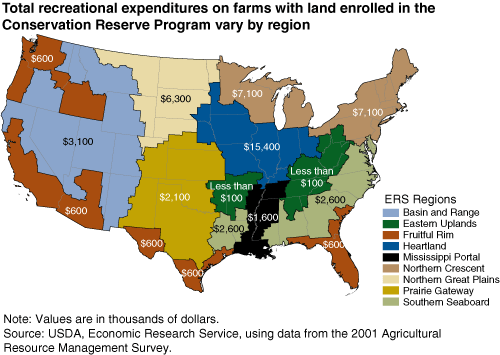Conservation Reserve Program Boosts Outdoor Recreation in Rural Communities
- by Daniel Hellerstein
- 11/1/2007
As growth in the biofuels industry increases demand for raw materials, market pressures to devote more land to crop production may lead to the conversion of millions of current Conservation Reserve Program (CRP) acres back to cropland. The 36.7 million acres of U.S. farmland currently enrolled in the CRP provide a range of environmental benefits. Those positive effects could be lost if CRP lands were brought back into production.
The CRP is a voluntary program run by USDA’s Farm Service Agency (FSA). Agricultural producers enrolled in CRP plant long-term, resource-conserving vegetative covers to improve the quality of water, control soil erosion, and enhance wildlife habitat. In return, FSA provides participants with rental payments and cost-share assistance. Contracts last from 10 to 15 years.
By improving wildlife habitat and air and water quality, CRP has significantly increased the number and variety of wildlife, attracting bird watchers, hunters, anglers, and other outdoor recreation enthusiasts, who then spend money in rural areas. In 2004, ERS research confirmed that the CRP’s environmental benefits can substantially increase recreational expenditures in rural counties. Based on data from national surveys of farmers and hunters, increases in recreational spending attributable to CRP enrollment are estimated to be as much as $290 million per year. This dollar amount includes revenue reported by farmers from recreational uses of their CRP land, as well as the nonfarm local spending of visitors to CRP land for outdoor recreation.
A number of simplifying assumptions were needed to arrive at this estimate, making its precision hard to gauge without more detailed information from landowners and outdoor recreation enthusiasts. However, other analyses also found similarly substantial economic benefits from CRP-induced recreation. For example, one study by Dean A. Bangsund, Nancy M. Hodur, and F. Larry Leistritz of North Dakota State University estimates that CRP lands in North Dakota attract about $13 million per year in recreation-related spending. The same attributes that attract hunters and other outdoor enthusiasts—clean air and water and a healthy ecosystem—create attractive landscapes that make rural communities more pleasant places in which to live and work.
This article is drawn from:
- Bucholtz, S., Sullivan, P., Hellerstein, D., Hansen, L., Johansson, R., Koenig, S., Lubowski, R.N., McBride, W.D., McGranahan, D., Vogel, S. & Roberts, M. (2004). The Conservation Reserve Program: Economic Implications for Rural America. U.S. Department of Agriculture, Economic Research Service. AER-834.


